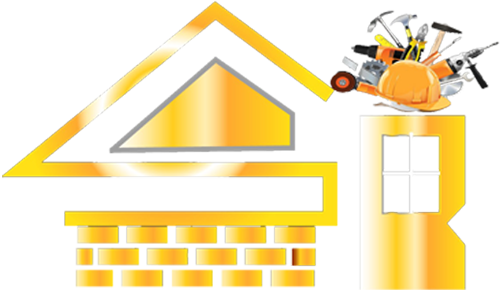Have you ever looked up at your roof and thought, “It looks fine… so why worry?”
You’re not alone. Many Brooklyn homeowners believe their roof is perfectly okay until a leak appears or shingles start falling off. The truth? Some of the most common ideas about roofing sound right but can quietly cost you thousands of dollars down the line.
Roofing myths are everywhere, passed along by neighbors, online forums, or even well-meaning handymen. These myths often shape how we care for our homes, especially in a place like Brooklyn where flat roofs, brownstones, and unpredictable New York weather create unique challenges.
In this guide, we’re breaking down the biggest roofing myths that mislead Brooklyn homeowners. You’ll see why some “common knowledge” about roofs doesn’t match the reality of local building codes, climate conditions, or modern roofing systems.
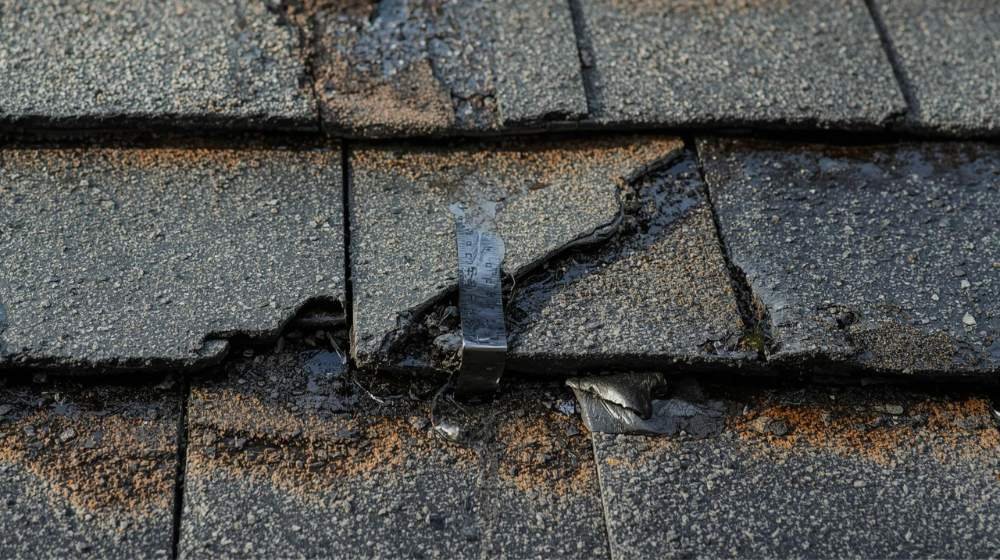
Common Roofing Myth 1: “You only need a new roof when it leaks.”
Why folks believe it: If water is not dripping, the roof must be fine.
What’s real: A leak is late. By the time water shows up inside, damage often sits under the membrane or shingles. Small faults around flashing, drains, and seams show up first. Waiting turns simple fixes into big bills. The National Roofing Contractors Association pushes twice-a-year checks because problems hide long before a ceiling stain shows. Spring and fall work best in our climate.
What this means for you in Brooklyn: Flat roofs on brownstones live with ponding water after heavy rain. Freeze-thaw, wind near the coast, and summer heat push materials hard. If you only act after a leak, you risk soaked insulation, deck rot, and mold.
Quick move: Put two dates on your calendar for inspections each year. Add a check after a major storm. A short visit now costs less than repairs later.
Myth 2: “A new roof can go over the old one.”
Why folks believe it: A “roof-over” sounds faster and cheaper.
What’s real in NYC: New York City’s code draws a hard line between replacement and recovery.
- Replacement means you remove all existing roof layers down to the deck. That is the rule.
- Recovering (a new layer over the old) is only allowed when strict conditions are met. No water-soaked roofing. No slate, clay, cement, or asbestos-cement tile. No roof that already has two or more layers. If any of those apply, a recovery is not allowed.
Permits: Most roofing projects in NYC need a DOB permit. Even when a job looks minor, you still must follow code. Always verify before work starts.
What this means for you in Brooklyn: A quick “roof-over” pitch can backfire. If the old layer holds moisture or the building already has multiple layers, code blocks the recovery path. A proper tear-off protects you, keeps you in compliance, and lets a pro fix hidden issues like bad decking or blocked drains.
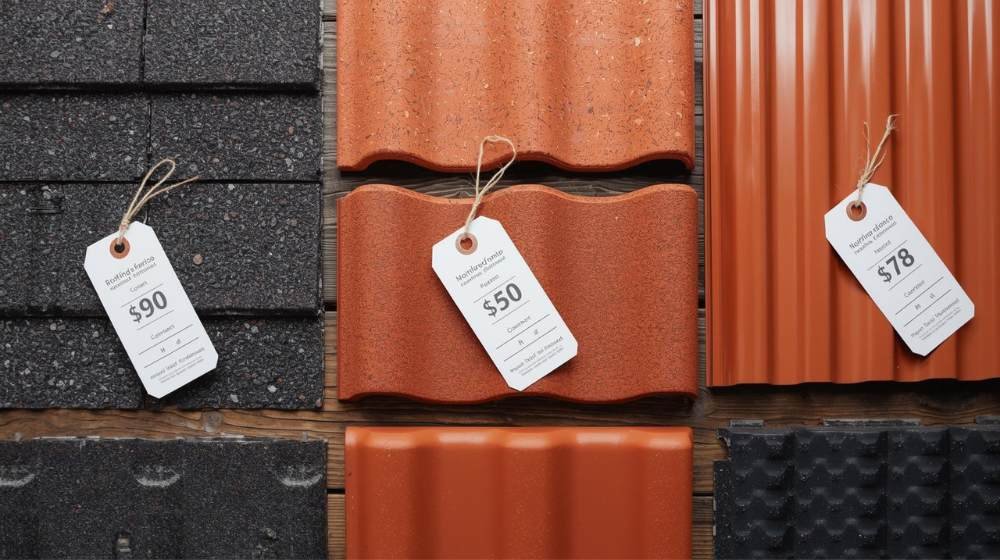
Myth 3: “Roofing materials are all the same.”
Why folks believe it: Shingles look alike from the street. Flat roofs look like one sheet.
What’s real: Materials do very different jobs.
- Steep-slope homes often use asphalt shingles, metal panels, slate, or tile. Each has a unique weight, fastening, wind rating, and fire class.
- Low-slope/flat roofs on many Brooklyn buildings rely on EPDM, TPO, PVC, modified bitumen, BUR, or liquids. These systems handle standing water and seams in different ways. They also age differently under sun and heat.
What this means for you in Brooklyn: A flat terrace over your top floor does not want “shingle logic.” You need the right membrane, proper slope to drains, and solid edge metal. Picking the wrong system or skipping key details invites pondering and future leaks.
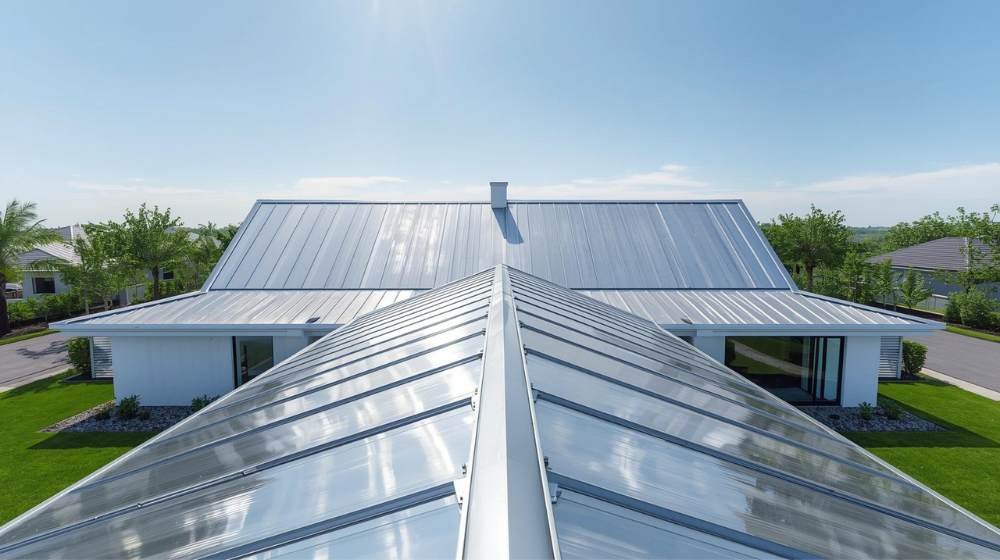
Myth 4: “Metal roofs attract lightning.”
Why folks believe it: Metal conducts electricity, so lightning must aim for it.
What’s real: Height, shape, and location drive a strike, not the roof material. Industry guidance based on NFPA 780 shows a metal roof is no more likely to get hit than other materials. If a strike happens, metal can help spread energy over a wide area, and it does not burn. Proper grounding and a code-compliant lightning protection system lower risk further.
What this means for you in Brooklyn: If you like metal for durability or style, fear of lightning should not stop you. Talk to your contractor about grounding and any needed protection on taller or exposed buildings.

Myth 5: “Flat roofs always leak.”
Why do people believe it? You see ponded water on a brownstone after rain, so a leak must be next.
What’s real: A well-built flat roof stays dry when you give it positive drainage, solid details at edges and penetrations, and routine care. Industry guidance asks for positive drainage because ponding water hurts roof systems when water sits for about 48 hours or more. That’s a widely used benchmark from manufacturers and trade groups.
What matters in Brooklyn: Parapet walls, scuppers, and interior drains do the heavy lifting on rowhouses and walk-ups. NYC code also calls for secondary (overflow) drains or scuppers wherever water could get trapped. That backup path saves you if a primary drain clogs.
How flat roofs avoid leaks:
- Build or retrofit slope to drains. A common target is about ¼ inch per foot for low-slope assemblies, paired with tapered insulation and crickets around big units.
- Keep drains, strainers, and scuppers clear. Add overflow routes where code expects them.
- Fix low spots. Don’t accept chronic ponding that keeps water in place after storms.
Bottom line for you: Flat roofs don’t “always leak.” Flat roofs fail when drainage, detailing, or upkeep falls short. Give the water a way out, and the system holds up.
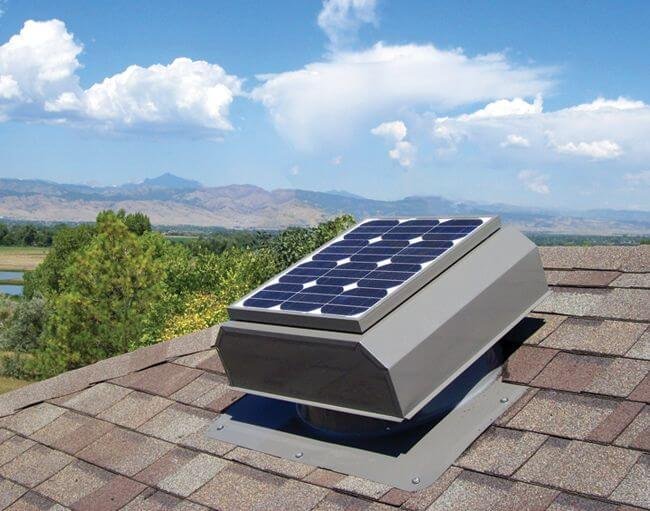
Myth 6: “You don’t need to worry about ventilation.”
Why people believe it: The attic feels separate from your living space, so it must not matter.
What’s real: Ventilation helps control moisture and heat in the roof assembly. Most codes require attic ventilation in vented designs, with a typical 1:150 net-free-area rule or 1:300 when you meet specific balance and vapor-retarder conditions. Building-science authorities also note that some roofs work as unvented assemblies, but those follow different code paths and air/thermal control layers.
Why you should care in Brooklyn: Winter moisture loves a cold attic. That moisture can soak insulation, then the R-value drops and the ice-dam risk rises. Summer heat loads the top floor. Balanced intake plus exhaust vents let air move through the cavity and cut those risks. The Department of Energy also points to moisture control as a core attic priority.
Simple moves for you:
- If your roof is a vented design, target balanced intake and exhaust and size vents with the code ratio you qualify for.
- If your roof is unvented (conditioned deck), make sure a qualified pro follows the unvented provisions rather than mixing approaches.
Bottom line for you: Ventilation is not an “extra.” It protects the roof, the insulation, and the top floor of your home.

Myth 7: “If it’s not leaking, it’s fine.”
Why people believe it: No stain on the ceiling means no problem.
What’s real: A leak you can see is often late-stage. Moisture can get in at a parapet, skylight curb, or seam, then travel before it shows inside. Trade guidance urges scheduled roof inspections at least twice a year—spring and fall—so small issues do not snowball.
Hidden trouble to watch:
- Wet insulation loses thermal performance. Even modest moisture content can drag R-value down, and then bills go up.
- Subsurface moisture does not show from the street. Pros use infrared scans or other nondestructive tests to find wet zones inside a flat roof. There is even an ASTM practice that describes how to locate wet insulation with infrared imaging.
Bottom line for you: Plan checks before leaks appear. Keep photos and notes, then act on early signs around flashing, drains, and parapets. Your roof lasts longer when you play offense.
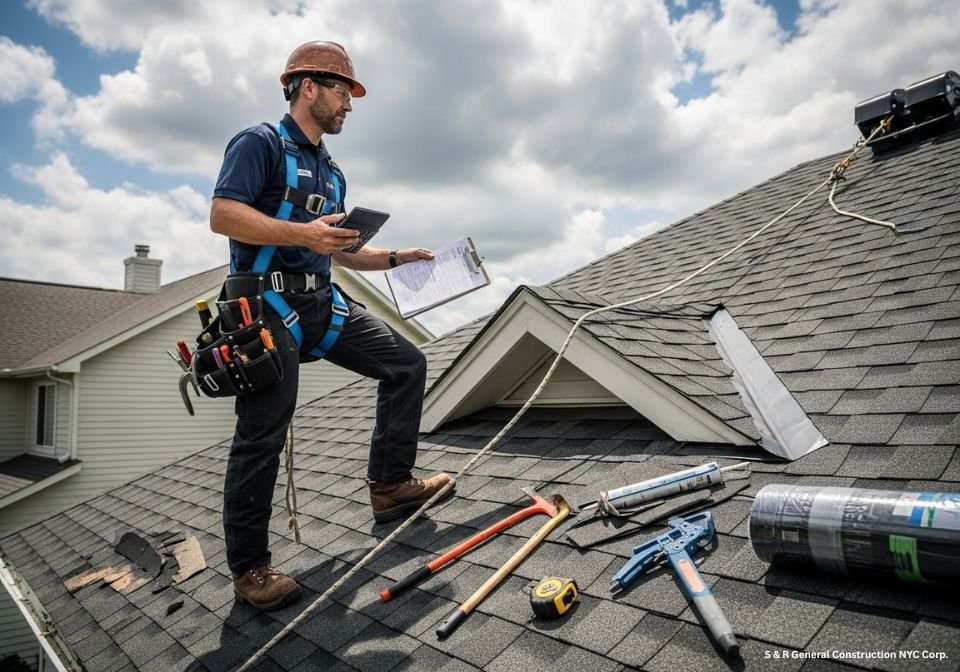
Myth 8: “You can always spot roof damage from the ground.”
Why people believe it: If shingles look tidy and no water drips, everything must be fine.
What’s real: Many failures hide where you can’t see from the sidewalk—at drains, scuppers, field seams, skylight curbs, chimney flashing, and parapet coping. Industry guides call for on-roof inspections and, when needed, nondestructive tests to catch what eyes on the street miss.
Brooklyn examples you might miss from below:
- Debris inside a drain strainer or a blocked overflow scupper on a low-slope roof. NYC plumbing code even requires a secondary overflow path where water can get trapped. You won’t confirm that from the ground.
- Edge metal or coping that loosened under wind. You see a straight line from the curb, yet fasteners or sealant fail at the top.
- Tiny seam openings or blisters in a membrane. Those start small, then grow after heat and rain cycles.
Bottom line for you: Ground-only checks give a false sense of security. Put safe, scheduled roof-level inspections on your calendar and bring in a licensed pro when access or testing gets tricky.
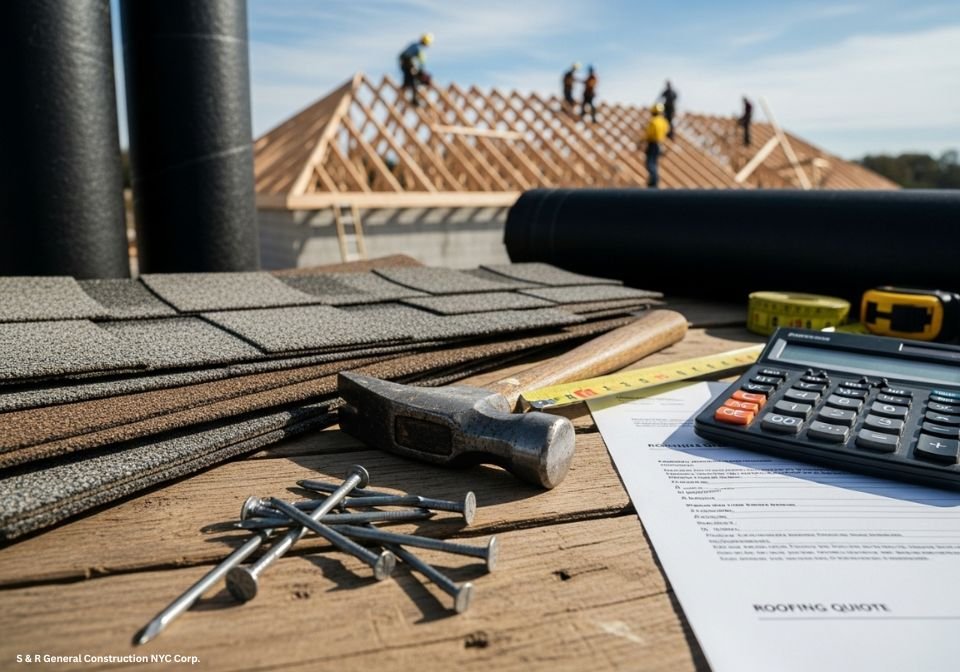
Myth 9: “All roofing materials are the same.”
Why folks believe it: From the street, a shingle looks like a shingle, and a flat roof looks like one dark sheet. So the choice must not matter, right?
What’s real: Materials work in very different ways, and they fit different roof shapes.
- Steep-slope roofs (think pitched houses) use shingles, metal, slate, or tile. Each option has its own fire rating and wind performance. Asphalt shingles even carry wind ratings based on ASTM D7158 classes, which test how well shingles resist uplift.
- Low-slope/flat roofs (common on Brooklyn brownstones and multifamily buildings) use membranes and multi-ply systems such as EPDM, TPO, PVC, modified bitumen, BUR, or liquid-applied systems. The details at seams, drains, and parapets vary by system. Inspectors and trade manuals separate “steep-slope” and “low-slope” for a reason.
- Service life depends on design, installation, and care. For example, industry papers show well-designed EPDM roofs can last 25 years or more, with long life tied to design choices and maintenance, not just the name on the box.
What this means for you in Brooklyn: A rowhouse with a flat terrace needs drainage details and edge metal that suit membranes. A single-family with a steep roof needs shingle or metal details that meet wind and fire rules. Treat them as the same, and problems follow.
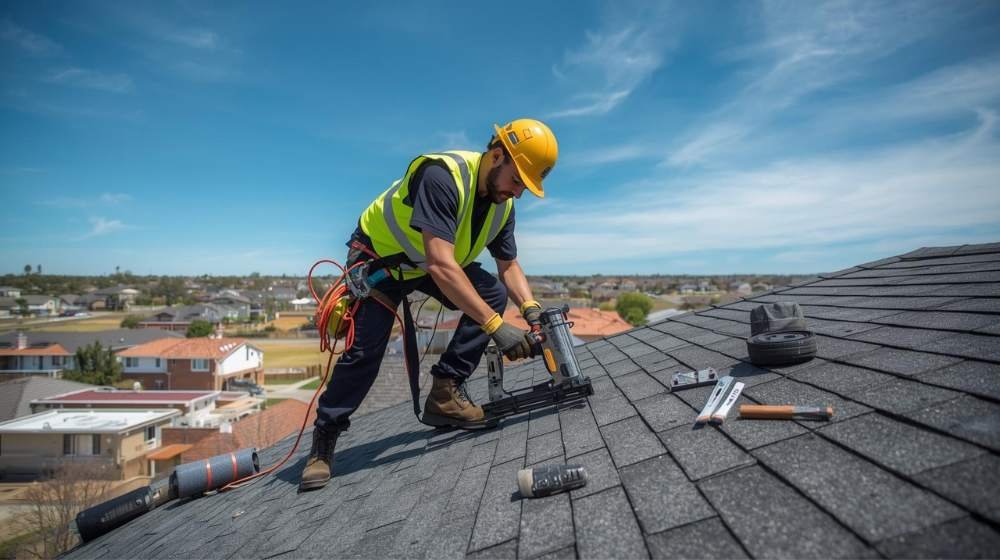
Myth 10: “I can just do it myself.”
Why folks believe it: DIY saves money on paint and shelves, so a roof must fit the same playbook.
What’s real: Roof work has real safety and compliance risks.
- Falls kill workers every year. OSHA and BLS report that falls are the leading cause of death in construction. In 2023, there were 421 fatal falls to a lower level. Roofing contractors account for a large share of those deaths. A slip near a parapet or ladder can change your life in a second.
- Permits and code still apply. NYC allows some minor repairs without a permit, yet many roofing projects require Department of Buildings approval. If you guess wrong, you risk fines and problems with resale or insurance.
- Warranties can depend on who installs the roof. “Enhanced” manufacturer warranties often require a credentialed contractor. Example: GAF Golden Pledge requires a GAF Master Elite contractor. CertainTeed SureStart PLUS requires a Credentialed contractor. Do it yourself, and those upgrades stay off the table.
What this means for you in Brooklyn: A licensed pro knows DOB rules, safe access on tight streets, and the right way to document the job for warranty files. Your cost stays under control when the work passes inspection the first time.
Common materials and systems for roofing in Brooklyn (what you should know)
Brooklyn has a mix: pre-war brownstones, walk-ups, and newer multifamily buildings. Many of them use low-slope/flat roofs. Here’s a quick local map so you can match the system to the building.
Low-slope / flat roofs (very common on brownstones and multifamily)
- EPDM (single-ply rubber): Flexible and time-tested. Industry literature shows long service life when design and care stay on point. Best with clean detailing at penetrations and edges.
- TPO / PVC (single-ply thermoplastic): Heat-welded seams and reflective white surfaces that help with heat. Lifespan depends on product quality and weld work. Good installers matter a lot.
- Modified bitumen / BUR: Multi-ply systems with robust redundancy. Good for traffic paths and complex roofs when details are right.
- Liquid-applied systems: Useful on tricky shapes and repairs when a designer specifies the right chemistry and thickness.
Drainage and code basics you should care about
Flat roofs in NYC must move water. The NYC Building Code §1503.4 requires roof drainage. When parapet walls trap water, code calls for secondary (overflow) drains or scuppers so storms do not flood the roof if a primary drain clogs. That backup path saves interiors in heavy rain.
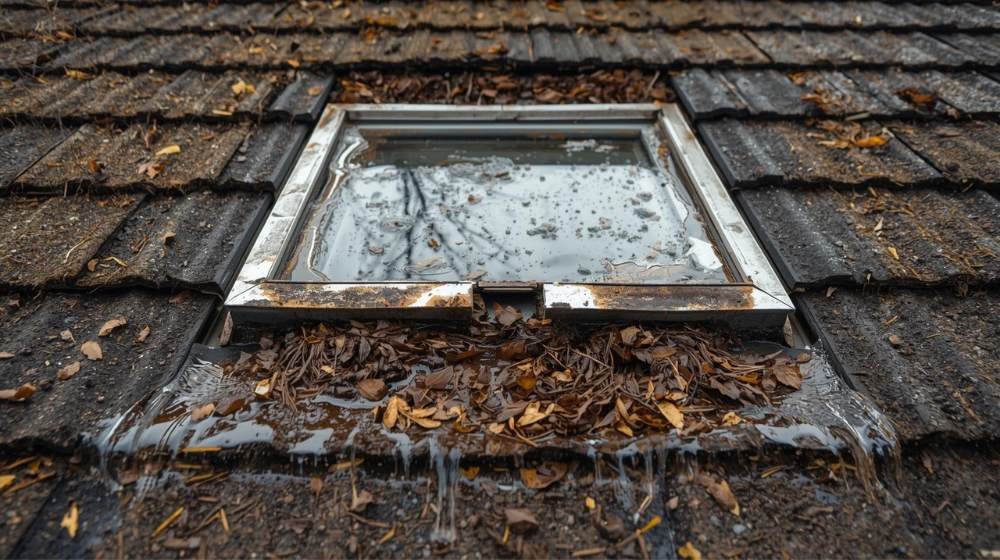
Where to Find the Best Brooklyn Roofing Contractors
Are you looking for an expert roofing contractor in Brooklyn, NYC? SR General Construction has you covered! Our business is located at 8807 Avenue B, Brooklyn, NY 11236, United States, in the Canarsie area.
We proudly serve all areas of Brooklyn with high-quality, durable roofing solutions. From new installations to repairs and maintenance, we provide the best service at affordable prices. Contact us and experience why we’re Brooklyn’s roofing experts!
FAQ
1. Do flat roofs always leak in Brooklyn?
No. Modern low-slope systems (TPO, EPDM, and modified bitumen) work reliably when they’re designed for positive drainage and have code-required secondary drains or scuppers where parapets can trap water. The NYC Building Code and Plumbing Code spell this out.
2. Can I put new shingles over old ones in NYC?
For a “roof replacement,” NYC requires removing all existing layers down to the deck. “Roof recovery” (an overlay) is limited by the code and is not allowed if there are already two layers or other listed conditions.
3. Do I need a DOB permit to replace my roof in Brooklyn?
Minor, nonstructural repairs may be permit-exempt, but full replacements and most substantial work require DOB permits. NYC lists permit-exempt categories and a “Do I need a permit?
4. How often should I have my roof inspected?
NRCA recommends inspections at least twice a year, spring and fall, and after severe weather. That cadence helps catch small issues before they become leaks.
5. What does “positive drainage” mean on a flat roof?
Industry and code guidance define ponding as water that remains more than ~48 hours after rain; positive drainage means the roof clears water within that window. Designers often target a ¼-in-per-foot slope to achieve this.
6. How long do asphalt shingles last in NYC?
Typical life is about 20–30 years depending on product and exposure. Heat, UV, wind, and installation quality affect the real-world range.
